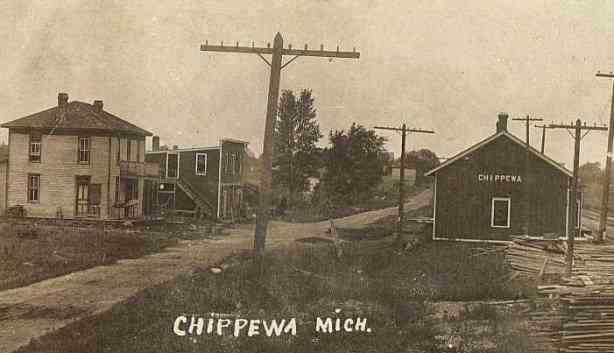
"Photo courtesy of Genealogy Trails, Paul Petoskey collection."
Chippewa Station, hotel and store, circa 1911.
Chippewa:
This cache is on the Pere Marquette State Trail near the depot site of the Pere Marquette Railroad at Chippewa. It is accessible by bicycle or on foot, or by snowmobile, however the cache is not winter friendly. Access to the trail is available at the intersection with 15th Avenue and 5 mile, 1/3 mile west. A trail near the curve where 5 mile turns south to 10th avenue may be usable when it is dry.
Chippewa was a timber settlement that sprang up on the on the Flint and Pere Marquette Railroad in Section 11, T17N, R7W (Orient Township) in Osceola County. According to the Michigan State Gazetteer and Business Directory, in 1897 the town had a population of 50, likely down from previous years when the timber harvest was in full swing. The town had a post office, a hotel, a general store, a shingle mill, and a school house. By 1907, the population was down to 30 and a livestock yard was added. Today, the settlement is gone. There are a few houses in the area, most of which are used for hunting cabins. It isn’t clear when the settlement dried up, but it was likely very early in the 20th century.

Plat Book of Osceola County, Michigan, P.A. Myers, Consolidated Pub. Co., 1900, courtesy of UofM Digital Library.
1900 plat of Chippewa.
Flint and Pere Marquette Railroad:
The rail line through Chippewa got its start in 1860 when the Flint and Pere Marquette Railroad began constructing a line between Mt. Morris and Saginaw. It was opened in January of 1862. It reached Flint in December of that year, Holly in 1864, Midland in 1867, and Averill in 1868. By the end of 1870, the line had extended to Clare and Lake. It finally reached Chippewa, Evert and Reed City in 1871. By 1874, the line extended to Ludington where a cross-lake break bulk and railroad car ferry service was created.
On January 1st, 1900, the F&PM, Chicago and West Michigan, and Detroit, Grand Rapids and Western were consolidated as the Pere Marquette Railroad, becoming the largest rail line in Michigan. The PM grew to a peak of 2393 miles with lines extending into Ontario, Indiana and Ohio and elsewhere with trackage rights. In 1929, the Chesapeak & Ohio Railroad had a controlling interest in the PM and consolidated the PM into the C&O in 1947. In 1972, the C&O, Baltimore and Ohio and Western Maryland were consolidated on paper as the Chessie System, keeping their individual identities until the late 1980’s. In 1980, the Seabord Coast Line was added and the new company was known as CSX Corporation. CSX began to downsize its operations and in doing so, began to dismantle this line. In 1987, the portion of the line from Midland to Baldwin was taken out of service, and officially abandoned in 1988.
One of the railroads that was incorporated to create the Detroit, Lansing and Northern was the Ionia, Stanton and Northern. The business goal of the DL&N for the IS&N was to reach Chippewa on the F&PM. That never happened. One wonders if the fate of the town would have changed if it had.
Just a few feet to the west of the hide, I noticed several very old tree stumps that had been cut off at the same height. I wonder if these were pilings for the depot.
Sources:
F&PM Pere Marquette Railroad
Chesapeake and Ohio Railroad
CSX
Pere Marquette Historical Society
C&O Historical Society
[agh]
